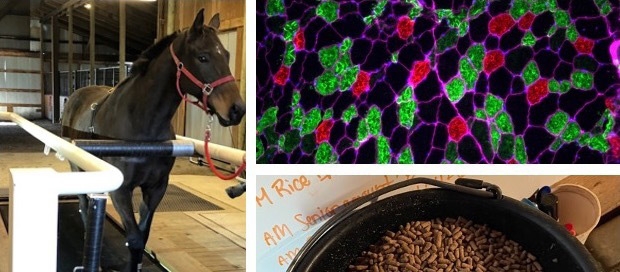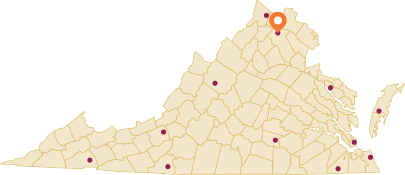Middleburg Agricultural Research and Extension Center
ID
AREC-187NP (AREC-298NP)
MIDDLEBURG
Agricultural Research and Extension Center

An elite thoroughbred racehorse can burn up to 30,000 kilocalories daily making nutrition an integral component underlying athletic success. Nutrition also plays a role in the post-race recovery period in meeting the energetic demands of the racehorse.
Skeletal muscle accounts for nearly one-half of the body weight of a mature Thoroughbred and is the driving force behind athletic performance. Ensuring timely recovery and repair of muscle allows for fewer injuries and lost training days. Key to repair efforts are satellite cells, the resident stem cells found in skeletal muscle. These normally inactive cells become active in response to muscle damage and are required for repair of the tissue. Traditionally, amino acid supplements and added vitamins and minerals are incorporated into diets to assist with improved muscle recovery following a bout of exercise. The means by which they affect the satellite cell population are largely unresolved.
Ongoing research at the MARE Center examines the impact of diet supplements on muscle metabolism and satellite cell activities. Through an improved understanding of how these recovery aids affect satellite cells, more effective strategies to offset muscle damage and enhance repair can be designed.

“My research at Tarleton State examined the effect of trailering, a stress event for horses, on hindgut function. We found that stress alters gut microbiome composition. As a Ph.D. student, I’m excited to extend my interests in stress physiology to the exercising horse and to develop new mitigation strategies through nutrition.”
KYLA SZEMPLINSKI
PH.D. STUDENT

“The MARE Center’s connections within the equine industry have assisted with the rehoming of several of our retired thoroughbred’s giving them new jobs after racing. Those entering the research herd at the Center provide an added benefit of giving back to future generations of racehorses through improved nutrition and management programs.”
LAUREN ZAGNIT
PROGRAM COORDINATOR, NEW START FOR HORSES
MIDDLEBURG AREC AT A GLANCE

DISCIPLINES
- Equine nutrition and exercise physiology
- Equine health and disease
- Animal behavior and psychology
- Ecosystem management
- Biodevice design
INNOVATIVE TECHNOLOGIES
- Smart apps for nutrition and exercise decisions
- The best management practices living laboratory
- Pasture grasses for water and carbon sequestration
FACILITIES
- 420 acres
- Exercise and nutrition barns
- Nature trail and conservation area
- Office building and conference room
INDUSTRY PARTNERS
- Equine nutritionists
- Conservation groups
- Grassland and forage specialists
ABOUT THE MIDDLEBURG AREC
The Middleburg Agricultural Research and Extension Center was established in 1949 through the generous donation of land and facilities by the late Paul Mellon. Our mission is to provide the stakeholders of Virginia and the wider equestrian community with innovative research, translational technologies, and state-of-the-art education through research, teaching, and outreach efforts.
A COLLABORATIVE NETWORK
The ARECs are a network of 11 centers strategically located throughout the state that emphasize close working relationships between Virginia Agricultural Experiment Station, Virginia Cooperative Extension, and the industries the work with. The mission of the system is to engage in innovative, leading-edge research to discover new scientific knowledge and create and disseminate science-based applications that ensure the wise use of agricultural, natural, and community resources while enhancing quality of life.

PARTNER WITH US
5527 Sullivans Mill Road Middleburg VA 20117
(540) 687-3521
www.arec.vaes.vt.edu/arec/middleburg/
MARECenter


Virginia Cooperative Extension materials are available for public use, reprint, or citation without further permission, provided the use includes credit to the author and to Virginia Cooperative Extension, Virginia Tech, and Virginia State University.
Virginia Cooperative Extension is a partnership of Virginia Tech, Virginia State University, the U.S. Department of Agriculture (USDA), and local governments, and is an equal opportunity employer. For the full non-discrimination statement, please visit ext.vt.edu/accessibility.
Publication Date
January 1, 2024



